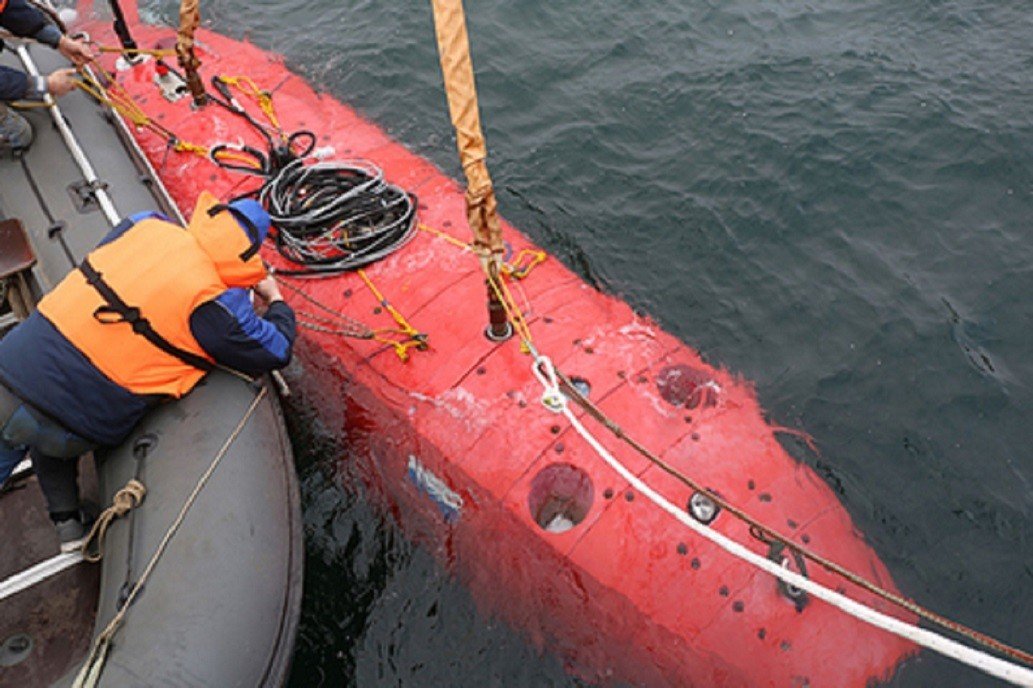Russian drone mini-sub plants memorial in WORLD’S DEEPEST Mariana Trench – all by its lonesome robotic self

A fully autonomous Russian drone has dived over 10 kilometers deep, reaching the bottom of the Mariana Trench, the deepest part of the Pacific Ocean. It even planted a buoy-like V-Day memorial to forever sway in the deep.
The deepest point of the plunge was registered at 10,028 meters, according to Russian Foundation for Advanced Research Projects, a defense research body that funded the creation of the drone. It technically means that the submersible could have gone deeper if it were to descend into the Challenger Deep, the lowest part of the trench, that's around 11 kilometers from the surface, but the team apparently chose a spot with a bit more space for maneuvers.

The achievement is nevertheless impressive. A handful of unmanned submersibles reached the more-than-10km depth, including Japan's Kaiko and ABISMO craft, China's Haidou-1 or the American Nereus. The Russian Vityaz robotic craft stands out because it's not a traditional remotely-operated vehicle (ROV) but a fully autonomous deepwater drone.
The mission forms part of sea trials of the new Russian craft aimed at testing its capabilities. Its creators say it can operate under pressure levels that would be found at 12km depth, if such a place could be found on earth. Its electronic brain utilizes artificial intelligence algorithms to detect and avoid obstacles and to maneuver in constrained spaces.
Вымпел под водой.Российское научное судно впервые погрузилось на дно Марианской впадины. Датчики необитаемого подводного аппарата "Витязь" зафиксировали глубину 10 028 метров.Аппарат установил на дне впадины вымпел в честь 75-летия Победы в Великой Отечественной.Фото: ФПИ pic.twitter.com/YKWdh0SgsA
— ВЕСТИ (@vesti_news) May 9, 2020
Trying to sniff out the military implications of such a vehicle has been a hot topic in the media. It is said that the Russian drone could be paired with a deepwater station: The Vityaz and the station both can communicate with a surface ship via a hydroacoustic channel in real time. The Russian Navy isn't giving out its plans, but it would probably like the idea of underwater stations able to detect enemy submarines in the deep where regular means of detection don't work that well.
The drone's name is an old Russian word for "warrior," but it's actually named after an old flagship of the Soviet research fleet. The original vessel, civilian at her launch, had a stint as a Nazi German support ship and changed its flag to the Soviet one in 1949, leading to two decades of oceanographic research. She even measured the depth of the Mariana Trench in 1957.
В отличие от работавших ранее в этом районе аппаратов Kaiko и Nereus, аппарат «Витязь» функционирует полностью автономно pic.twitter.com/e8i58uC0Df
— Maxim Vorontsoff (@VrffMax) May 9, 2020
The modern submersible drone came back to the chasm to spend three hours near the seabed, conducting some mapping and sampling and planting a banner. Unlike the Mir submersible, which tellingly planted the Russian flag during the 2007 expedition in the Arctic, this expedition only carried a special buoy-like memorial dedicated to the 75th anniversary of the defeat of the Nazis, which Russia celebrated on Saturday.
Also on rt.com Russia’s mightiest military aircraft buzz over Moscow to mark 75th anniversary of Nazi defeat (PHOTO, VIDEO)Like this story? Share it with a friend!













